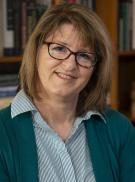
Barbara Skinner
Associate Professor of History, Indiana State University
When did you first develop an interest in Slavic, East European and Eurasian Studies?
I owe my interest in this field to my Russian language classes in my undergraduate studies at Yale. I wanted to take a language that was decidedly different from the Spanish foisted on me in school, and I had a vague interest in Russian literature and culture – so why not? Those language classes opened up a whole new world, and I became so enamored by it, I switched my major from English to Russian and East European Studies.
How have your interests changed since then?
Not globally, but in terms of disciplinary focus, yes. When I began my graduate studies at Georgetown in 1991, I continued with an area studies master’s degree. It was only then that I began to gravitate toward the discipline of history and, eventually, a Ph.D. in history. In terms of the topics I cover in my research, my interest in the Orthodox Church and goes back to a course on the subject that I took at Yale, but at Georgetown I began to consider overlapping issues of Russian imperial policies and identity. I had, since my time at Yale, spent time in Poland and learned Polish as well, developing an interest in Polish history. Professor Andrzej Kaminski at Georgetown introduced me to the history of the Polish-Lithuanian Commonwealth, and this became the geographic area that I research within the Russian Empire.
While that is my focus in my research, my teaching interests remain broad. I teach the entire gamut of Russian history from Kyivan Rus to Vladimir Putin, and so I try to follow scholarship on every era I cover. I approach my teaching of this region from the perspective of my initial area studies training – particularly incorporating literature, art, architecture, film, and ethnography into my courses. History is a wonderful umbrella under which almost every subject fits.
What is your current research/work project?
My current project is more or less a sequel to my first book (The Western Front of the Orthodox Church: Uniate and Orthodox Conflict in 18th-century Poland, Ukraine, Belarus, and Russia), which dealt with the intense religious tensions in the region of Poland-Lithuania that came under Russian rule during the partitions in the late 18th century. That book explored the culture and defining characteristics of the Uniate Church in the 18th century as it became more distinguished from Eastern Orthodoxy and then described Russian imperial policies after the partitions that led to the absorption of about 1.3 million Uniates, mostly Ukrainians, into the Russian Orthodox Church by 1796, with an eye on the impact of this policy on cultural identity in this region.
Now I am continuing my assessment of changing cultural identity in Belarus and Ukraine under Russian rule by assessing the fate of the Belarusians and Ukrainians before, during, and after the mass conversion finalized in 1839 under Nicholas I that brought an additional 1.5 million Uniates – this time mostly Belarusians – into the Russian Orthodox fold. Again, I am dealing with issues of identity construction within the Russian Empire, but primarily asking questions of how this massive shift in confessional identity unfolded on the ground. What did priests and parishioners experience? When and where was force used? Why did some areas conform peacefully, while others resisted? What was the fate of those who resisted? What was the actual process of “conversion”? How did the material culture of the parish and the rituals and rites change? How did the shift to Orthodox religious education change the intellectual milieux of these regions? To what extent did these parishes become “Orthodox”? Overall, what did it mean for Ukrainians and Belarusians to lose a major avenue of Polish and Western influence? And how did this mass conversion, which expanded the Orthodox core of the empire, affect Russian imperial identity? Covering eight provinces of the Russian Empire, the research for this project involved work in archives of Lithuania, Belarus, Ukraine, and Russia, which I carried out primarily in 2012 (funded by NCEEER and ACLS). Now, thanks to an NEH Fellowship, I am looking forward to a year-long leave from my duties at ISU next year to write up this research.
What do you value about your ASEEES membership?
ASEEES membership has been and continues to be critical to my career. I work on a campus that does not have an area studies program, or even Russian language or any other East European-focused courses, so that I do not have colleagues with whom I can discuss my research and teaching on this part of the world. Therefore, the promotion and documentation of efforts in the field provided by ASEEES through Slavic Review, NewsNet, the website, and the annual conventions constitutes my primary and essential link to new developments and issues relating to Eurasia and Eastern Europe. I continually turn to these materials for content in my teaching, as well as in my research. The annual conventions provide invaluable opportunities to learn about new research, meet with colleagues in the field, and forge new contacts. Basically, ASEEES is my lifeline to my field.
Besides your professional work, what other interests and/or hobbies do you enjoy?
Feeding my lifelong passion for literature, I read fiction. I’ll read anything, as long as it is well written. I have turned back to Dostoevsky and Gogol recently, but usually I’m escaping through fiction to other parts of the world. I also play classical piano, and a session at the piano does wonders to clear my head when I need it.
